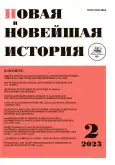Integration of the USSR into the International Patent-Licensing System in the Context of International Technological Cooperation (1950s – early 1970s)
- Authors: Zavodyuk S.Y.1, Zanin S.V.1
-
Affiliations:
- Samara State Medical University
- Issue: No 2 (2023)
- Pages: 122-133
- Section: 20th century
- URL: https://journals.rcsi.science/0130-3864/article/view/140233
- DOI: https://doi.org/10.31857/S013038640022379-4
- ID: 140233
Cite item
Full Text
Abstract
About the authors
Svetlana Yur'evna Zavodyuk
Samara State Medical UniversityRussian Federation, Samara
Sergey Viktorovich Zanin
Samara State Medical UniversityRussian Federation, Samara
References
- Абрамов С.А. К вопросу о присоединении СССР к Парижской конвенции по охране промышленной собственности и правовом режиме средств индивидуации // Право и практика. 2020. № 2. С. 46–50.
- Боденхаузен Г. Парижская конвенция по охране промышленной собственности: комментарий / пер. с фр. Н.Л Тумановой; под ред. М.М. Богуславского; вступ. ст. Е.П. Питовранова М., 1977.
- Богуславский М.М. Основные вопросы изобретательства в международном частном праве. М., 1960.
- Богуславский М.М. Правовые вопросы технической помощи СССР иностранным государствам и лицензионные договоры. М., 1963.
- Богуславский М.М. Участие СССР в международной охране авторских прав. М., 1974.
- Гаврилов И.П. 50 лет с даты вступления СССР в Парижскую конвенцию по охране промышленной собственности // Патенты и лицензии. Интеллектуальные права. 2015. № 7. С. 17–22.
- Дозорцев В.А. Правовой режим авторского свидетельства в условиях новой системы планирования и экономического стимулирования. М., 1969.
- Колесников А.П. История изобретательства и патентного дела: важнейшие события и факты в истории отечественного изобретательства. М., 2002.
- Липкин М.А. «Мировой кооператив народов»: Совет экономической взаимопомощи, который пытался построить Н.С. Хрущев // Новый исторический вестник. 2017. № 4 (54). С. 121–144.
- Максарев Ю.Е. Регистрация и правовая охрана открытий и изобретений // Вестник РАН. 1977. № 11. С. 69–74.
- Некрасов В.Л. Советский экономический реформизм эпохи Н.С. Хрущева: авторитарный реформатор, партийно-государственная система и академическое сообщество // Новый исторический вестник. 2017. № 4 (54). С. 71–91.
- Соленцова Е.А., Солдатова О.Е. Советская патентно-лицензионная практика 1960-х гг. сквозь призму международного трансфера технологий // Наука XXI века: актуальные направления развития. 2021. № 2–1. С. 106–110.
- Ханин Г.И. Экономическая история России в новейшее время: в 2-х т. Т. 1. Экономика СССР в конце 30-х годов – 1987 год. Новосибирск, 2008.
- Шаршунов В.А. История создания и совершенствования государственной системы защиты интеллектуальной собственности в СССР // Проблемы управления. 2009. № 3 (32). С. 208–214.
- Burrus B.R. The Soviet Law of Inventions and Copyright // Fordham Law Review. 1962. Vol. 30 (4). P. 693–726.
- Roit N. Soviet and Chinese Copyright: Ideology Gives Way to Economic Necessity // Loyola of Los Angeles Entertainment Law Review. 1986. Vol. 6. № 1. P. 53–71. URL: https://digitalcommons.lmu.edu/cgi/viewcontent.cgi?article-1081&context-elr (дата обращения: 19.11.2022).
Supplementary files










